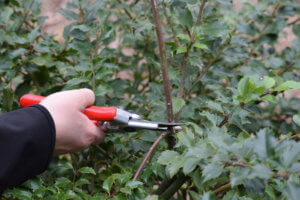Renewal pruning has immediate, delayed rewards
June 4, 2019
Q: I have 2 Forsythias, 2 Spireas, a Ninebark and a variegated Dogwood that appear to be half dead. My thought is to cut them down now to regrow so they’ll have all summer to do this. What are your thoughts? Last year all of these bushes were lush and full.

Cut dead or damaged branches back by “heading back” to an outward facing branch or side bud.
Photo Credit: Purdue Extension
A: Although it could be done now, late winter is the ideal time of year to completely cut the shrubs to the ground. But there is some renewal pruning that you can do now to help the plants look better. Dead branches can be removed any time of year. Cut those back to the ground or to a side branch that is facing in the direction you want the new growth, a technique called heading back (see photo).
Then, if needed, thin the plants using a more gradual rejuvenation process known as renewal pruning. This three-stage process results in a completely new plant at the end of three growing seasons. The first year, remove one-third of the oldest, largest-diameter stems completely back to ground level. For example, if a shrub has 15 stems coming from the base, remove five of the largest stems completely back to the ground. The second year, remove the next five oldest, largest stems, and the third year remove the last five oldest, largest stems. By this time, all stems of the plant are no more than 3 years old. Alternatively, you could remove just the dead branches now and do the more drastic rejuvenation pruning (cutting back to the ground) next year in late winter or early spring before the new growth begins.
You’ll find additional information in Purdue Extension Bulletin HO-4, Pruning Ornamental Trees and Shrubs. https://mdc.itap.purdue.edu/item.asp?itemID=22785